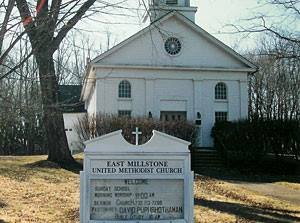
A proposed design for new historic village identification signs was shot down Dec. 3 by the Historic Preservation Advisory Commission.
The commission gave Tiffany Delaney, the township’s special projects coordinator, a new set of guidelines for what chairman Andrew Burian said he hoped would be a more “elegant” design.
The original plan, approved in October by the Open Space Advisory Committee, called for a blue sign with white lettering, supported by two posts.
Each of the three designated historic districts – East Millstone, Griggstown and Kingston – would get up to three of the so-called “gateway signs.” The signs would cost between $1,200 and $1,400 per village and would be paid for by the township’s Open Space Trust Fund, administered by the Open Space Advisory Committee.
But that didn’t sit well with the historic commission. Commissioner Barbara Lawrence presented Delaney with a set of guidelines the commission would like to see incorporated into the new signs’ design.
The commission wants the signs to be made of cast aluminum, with white backgrounds and black lettering, Lawrence said.
The commission would also like the signs to be supported by a single pole, anchored to a masonry base, she said.
Similar signs in other states have cost about $2,000 each, with the post costing about $300, she said.
The commission’s main objection to the proposed sign, Burian said, “was the bulkiness of it.”
“A single post is a little more elegant,” he said.
The language on the signs will be based on what’s now on a Griggstown identifying sign: “Historic Village of (name), Settled circa (blank), National and State Historic District in the Township of Franklin.”
Lawrence said the cost may be offset from the state, through money raised through the purchase of vanity license plates.
Commissioner Bob LaCorte asked how “tacky would it be” if local businesses were asked to sponsor the signs.
LaCorte said the business’s donation could be acknowledged by a small plaque at the bottom of the sign.
“I think sponsorships would be OK,” Burian said. “If we can get them through grants or sponsorships, that would be great.”
Noting that the three historic districts in question are so designated at the state and federal levels, Burian said the signs would “become precedents for future signage in the local-designated districts.”
 The Franklin Reporter & Advocate Eight Villages, One Community
The Franklin Reporter & Advocate Eight Villages, One Community

